2007 年全国卷 I 高考英语真题及答案
本试卷分第 I 卷 ( 选择题 ) 和第 II 卷(非选择题)两部分。第 I 卷 1 至 12 页。第 II
卷 13 至 14 页。考试结束,将本试卷和答题卡一并交回。
注意事项:
第 I 卷
1 .答题前.考生在答题卡上务必用直径 0 . 5 毫米黑色墨水签字笔将自己的姓名、
准考证号填写清楚,井贴好条形码.请认真核准条形码上的准考证号、姓名和科目。
2.每小题选出答案后,用 2B 铅笔把答题卡上对应题目的答案标号涂黑.如需改动,
用橡皮擦干净后,再选涂其他答案标号.在试题卷上作答无效。
第一部分听力 《 共两节.满分 30 分 》
做题时.先将答案标在试卷上。录音内容结束后,.你将有两分钟的时间将试卷上的答
案转涂到答题卡上。
第一节(共 5 小题;每小题 1.5 分,满分 7. 5 分)
听下面 5 段对话。每段对话后有一个小题,从题中所给的 A 、 B 、 C 三个选项中选
出最佳选项,并标在试卷的相应位置。听完每段对话后,你都有 10 秒钟的时间来回答有关
小题和阅读下一题.每段对话仅读一遍。
例:How much is the shirt?
A. £ 19.15.
B. £ 9. 15.
C. £ 9. 18.
答案是 B
I. Who is coming for tea?
A. John.; B. Mark. C. Tracy.
2. What will the man do next?
.A. Leave right away. B. Stay for dinner. C. Catch a train.
3. What does the man come for?
A. A lecture B. A meeting. C. A party.
4. What size does the man want?
A. 9. B. 35. C. 39.
5. What are the speakers talking about?’
A. Life in Southeast Asia. B. Weather conditions. C. A holiday tour.
第二节(共 15 小题;每小题 1 . 5 分,满分 22 . 5 分)
听下面 5 段对话或独白、每段对话或独白后有几个小题.从题中所给的 A、B、 C 三个选
项中选出最佳选项,并标在试卷的相应位置。听每段对话成独白前,你将有时间阅读各个小
题,每小题 5 秒钟;听完后,各小题将给出 5 秒钟的作答时间。每段对话或独白读两遍。
听第 6 段材料,回答第 6 、7 题。
6. What is the man doing?
A. Giving a speech.
B. Chairing a meeting.
C. Introducing a person.
7. Why does the woman sing so well?
�
A. She has a great teacher.
B. She teaches singing.
C. She is young.
听第 7 段材料,回答第 8 、9 题。
B. What is the second gift for Jimmy?
A. A car.
B. A watch,
C. A computer.
9. Why does Jimmy feel happy?
A. He lives with his parents.
B. He’s got what he dreamt of.
C. He’s received lots of presents.
听第 8 段材料,回答第 10 至 12 题。
10. What is the relationship between the speaker,?
A. They are friends.
B. They are strangers to each other.
C. They are husband and wife.
11. Why does the woman come to talk with the man?
A. To get a job. B. To take a teat, C. To see the secretary.
12. What does the man mean by saying sorry?
A. He can’t hear the woman clearly.
B. He doesn’t need a designer.
C. He can’t help the woman.
听第 9 段材料.回答第 13 至 16 题。
13. What do we know about the woman?
A. She lives close to the office.
B. She is new to the company.
C. She likes the big kitchen.
14. How does the man go to work?
A. On foot. B. By bus. C. By car.
15. Why was Susan Late for work?
A. She missed the bus. B. Her train was late. C. Her car broke dawn.
16. What will the man do the next day?
A. Go to work by train. B. Visit Lily in her flat. C. Leave home earlier.
听第 10 段材料,回答第 17 至 20 题。
17. When can you most probably hear this talk?
A. In a class of the English language.
B. In a class of the Greek language.
C. In a class of the French language.
18. How long does the class last?
A. 11 weeks. 8. 13 weeks. C. 15 weeks.
19. What is “the short-cut” to learning words according to the speaker?
A. Taking more courses. B. Reading basic words aloud.
C. Learning how words are formed.
�
20. Why is the class popular?
A. It is not offered each term. B. It’s taught by Professor Morris.
C. It helps to master some useful rules.
第二部分英语知识运用 (共两节.满分 45 分)
第一节单项填空(共 15 小题.每小题 l 分.满分 15 分)从 A、 B 、 C 、 D 四个选项
中,选出可以填入空白处的最佳选项.并在答题卡上将该项涂黑。
例:It is generally considered unwise to give a child ________ he or she wants.
A. however B. whatever C. whichever D. whenever
答案是 B
21. — Have you heard the latest news?
—No, what ______
A. is it B. is there C. are they D. are those
22. Some pre-school children go to a day care center, — they learn simple games
and songs.
A. then B. there C. while D. where
23. The manager suggested an earlier date _______ the meeting.
A. on B. for C. about D. with
24. —It’s a long time since I saw my sister.
— _________ her this weekend’
A. Why not visit B. Why not to visit
C. Why not visiting D. Why don’t visit
25. -The last one ____ pays the meal.
-Agreed!
A. arrived - B. arrives C. to arrive D. arriving
26. 1 won’t call you, ________ something unexpected happens.
A. unless B. whether C. because D. while
27. — How’s your tour around the North Lake? Is it beautiful?
—It_______ be, but it is now heavily polluted.
C. should D. must
A. will B. would
28. We all know that, _______, the situation will get worse.
A. not if dealt carefully with B. if not carefully dealt with
C. if dealt not carefully with D. not if carefully dealt with
29. 1 smell something ___________ in the kitchen. Can I call you back in a minute?
A. burning B. burnt C. being burnt D. to be burnt
30. Does this meal cost $50? I_______something far better than this!
A. prefer B. expect C. suggest D. suppose
31. Between the two generations, It is often not their age, ______their education
that causes misunderstanding. -
A. like B. as C. or D. but
32. I know a little bit about Italy as my wife and I _________ there several years
ago.
A. are going B. had been C. went D. have been
33. —Can you read the sign, sir? No smoking allowed in the lift!
A. Never mind B. Don’t mention it
�
C. Sure, I don’t smoke D. Pardon me
34. “Goodbye, then,” she said, without even ________ from her book.
A. looking down B. looking up C. looking away D. looking on
35. The flowers were so lovely that they _________ in no time.
A. sold B. had been sold C. were sold P. would sell
第二节完形填空(共 20 小题;共 20 小题,每小题 1 . 5 分.满分 30 分)
阅读下面短文,从短文后各题所给的四个选项(A、 B、 C 和 D )中,选出可以填入空白
处的最佳选项,并在答题卡上将该项涂黑。
In the United States there was an unusual tale telling of the daughter of a
mechanic (技工). One day while walking along the bank of a lake, the girl 36 to see
20 eggs laid by a wild goose. After some time the girl 37 the mother would not return
to her eggs and she 38 to take them home. There she carefully 39 the eggs in the
heat of a lamp. Several days 40 the eggs broke and the baby geese came into the 41.
Geese are known to take the first living thing they see as their mother. 42,
to these young geese, the girl was their mother.
As they 43, the girl was able to 44 her birds to run across the grass, but she
could not teach them to 45,. The girl became increasingly worried about this, both
when 46 and in her dreams. later, she had an 47 She would pilot a plane to guide
them in 48 . She asked her father for a plane and he assembled (组装) a small aircraft
for her.
Caring about 49 safety, the father decided to pilot the plane himself. However,
the birds did not 50 or follow him, and 51 slept in the grass.
B. Also
One day, the girl 52 into the plane, started it and soon left the 53, Seeing their
mother take to the air, the birds 54 flapped (拍打) their wings and 55. She flew
the plane freely in the sky, her young birds following.
36. A. managed B. attempted C. happened D. supposed
37. A. realized B. expected C. imagined D admitted
38. A. helped B. decided C. afforded D. meant
39. A. placed B. protected C. treated D. examined
40. A. ago B. out C. later D. long
41. A. family B. lake C. home D. world
42. A. But
43. A. increased B. improved C. rose D. grew
44. A. ask B. lead C. want D. allow
45. A. fly B. race C. swim D. sing
46. A. asleep B. away C. around D. awake
47. A. idea B. opinion C. explanation D. excuse
48. A. sky B. heaven C. flight D. plane
49. A. his B. her C. their D. its
50. A. respect B. remember C. recognize D. receive
51. A. so B. instead C. hardly D. too
52. A. climbed B. looked C. reached D. fell
53. A. house B. floor C. water D. pound
C. Thus D. Still
�
54. A. secretly B. disappointedly C. patiently D. eagerly
55. A. looked away B. set out C. went by D. turned back
第三部分阅读理解 (共 20 小题;每小题 2 分,满分 40 分)
阅读下列短文,从每题所给的四个选项(A、 B 、 C 和 D )中.选出最佳选项.并在答题
卡上将该项涂黑。
A
It was a winter morning, just a couple of weeks before Christmas 2005. While
most people were warming up their ears, Trevor, my husband, had to get up early to
ride his bike four kilometers away from home to work. On arrival, he parked his bike
outside the back door as he usually does. After putting in 10 hours of labor, he
returned to find his bike gone.
The bike, a black Kona 18 speed, was our only transport. Trevor used it to get
to work, putting in 60-hour weeks to support his young family. And the bike was also
used to get groceries (食品杂货) saving us from having to walk long distances from
where we live.
I was so sad that someone would steal our bike that I wrote to the newspaper
and told them our story. Shortly after that,several people in our area offered to
help. One wonderful stranger even bought a bike, then called my husband to pick ii
up. Once again my husband had a way to get to and from his job. It really is an honor
that a complete stranger would go out of their way for someone they have never met
before.
People say that a smile can be passed from one person to another, but acts of
kindness from strangers are even more so. This experience has had a spreading effect
in our lives because it strengthened our faith in humanity (人性) as a whole. And
it has influenced (影响) us to be more mindful of ways we, too, can share with others.
No matter how or how small, an act of kindness shows that someone cares. And the
results can be everlasting.
56. Why was the bike so important to the couple?
A. The man’s job was bike racing. B. It was their only possession.
c. It was a nice Kona 18 speed. D. They used it for work and daily life
57. We can infer from the text that ________
A. The couple worked 60 hours a week B. people were busy before Christmas
C. the stranger brought over the bike D. life was hard for the young family
58. How did people get to know the couple’s problem?
A. From radio broadcasts. B. From a newspaper.
C. From TV news. D. From a stranger.
59. What do the couple learn from their experience?
A. Strangers are usually of little help. B. One should take care of their bike.
C. News reports make people famous. D. An act of kindness can mean a lot.
B
Many animals recognise their food because they see it. So do humans. When you
see an apple or a piece of chocolate you know that these are things you can eat.
You can also use other senses when you choose your food. You may like it because
�
it smells good or because it tastes good. You may dislike some types of food because
they do not look, smell or taste very nice. Different animals use different sense,
to find and choose their food. A few animals depend on only one of their senses.
while most animals use more than one sense.
Although there are many different types of food, some animals spend their lives
eating only one type. The giant panda (大熊猫) eats only one particular type of bamboo
(竹子). Other animals eat only one type of food even when given the choice. A kind
of white butterfly (蝴蝶) will stay on the leaves of a cabbage, even though there
are plenty of other vegetables in the garden. However, most animals have a more varied
diet (多样化饮食). The bear eats fruits and fish. The fox eats small animals, birds
and fruits. The diet of these animals will be different depending on the season.
Humans have a very varied diet. We often eat food because we like it and not
because it is good for us. In countries such as France and Britain, people eat foods
with too much sugar. This makes them overweight, which is bad for their health. Eating
too much red meat and animal products, such as butter, can also be bad for the health,
Choosing the right food, therefore, has become an area of study in modern life.
60. We can infer from the text that humans and animals - —.
A. depend on one sense in choosing food B. are not satisfied with their food C. choose
food in similar ways D. eat entirely different food
61. Which of the following eats only one type of food?
A. The white butterfly. B. The small bird. C. The bear. D. The fox.
62. Certain animals change their choice of food when _________
A. the season changes B. the food color changes
C. they move to different places D. they are attracted by different smells
63. We can learn from the last paragraph that -— —
A. food is chosen for a good reason B. French and British food is good
C. some people have few choices of food D. some people care little about healthy
diet
C
Our ‘Mommy and ME” time began two years ago. My next-door neighbor and fellow
mother, Christie, and I were out in our front yards, watching seven children of age
6 and under ride their bikes up and down. l wish I could take one of my children
out alone,” said Christie.
Then we worked out a plan: When Christie takes one of her children out, 1’11 watch
her other three. And when she watches two of mine, I’ll take someone out.
The children were extremely quick to accept the idea of “Mommy and Me” time.
Christie’s daughter, McKenzie, went first. When she returned • the other children
showered her with tons of questions. McKenzie was smiling broadly. Christie looked
refreshed and happy. “She’s like a different child when there’s no one else around.
- Christie shared with me quietly. With her mother all to herself, McKenzie didn’t
have to make an effort to gain attention.
Just as Christie had noticed changes in McKenzie, I also discovered something
different in each of my children during our alone times. For example, I am always
surprised when my daughter, who is seldom close to mc, holds my hand frequently.
�
My stuttering (口吃) son, Tom, doesn’t stutter once during our activities since
he doesn’t have to struggle for a chance to speak. And the other son, Sam, who’s
always a follower when around other children shines as a leader during our times
together.
The “Mommy and Me” time allows us to be simply alone and away with each child
— talking, sharing, and laughing, which has been the biggest gain. Every child
deserves (应得到) to be an only child at least once in a while.
64. What is the text mainly about?
A. The experience of the only child being with mother.
B. The advantage of spending time with one child at a time.
C. The happy life of two families
D. The basic needs of children.
65. Right after McKenzie came back, the other children were _________
A. happy B. curious C. regretful D. friendly
66. What is one of the changes the author finds in her children?
A. The daughter acts like a leader. B. Sam holds her hand more often.
C. The boys become better followers. D. Tom has less difficulty in speaking.
67. The author seems to believe that _____.
A. having brothers and sisters is fun
B. its tiring to look after three children
C. every child needs parents’ full attention
D. parents should watch others’ children
D
Anyone who cares about what schools and colleges teach and how their students
learn will be interested in the memoir (回忆录) of Ralph W. Tyler, who is one of
the most famous men in American education.
Born in Chicago in 1902, brought up and schooled in Nebraska, the 19-year-old
college graduate Ralph Tyler became hooked on teaching while teaching as a science
teacher in South Dakota and changed his major 1mm medicine to education.
Graduate work at the University of Chicago found him connected with honorable
educators Charles Judd and W. W. Charters, whose ideas of teaching and testing had
an effect on his later work. In 1927, he became a teacher of Ohio State University
where he further developed a new method of testing.
Tyler became well-known nationally in 1938. when he carried his work with the
Eight-Year Study from Ohio State University to the University of Chicago at the
invitation of Robed Hutchins.
Tyler was the first director of the Center for Advanced Study in the Behavioral
Sciences at Stanford, a position he held for fourteen years. There, he firmly
believed that researchers should be free to seek an independent(独立的)spirit in
their work.
Although Tyler officially retired in 1967, he never actually retired. He served
on a long list of educational organizations in the United States and abroad. Even
in his 80s he traveled across the country to advise teachers and management people
�
on how to set objectives (目标) that develop the best teaching and learning within
their schools.
68. Who are most probably interested in Ralph W. Tyler’s memoir?
A. Top managers. B. Language learners.
C. Serious educators.
69. The words “hooked on teaching” underlined in Paragraph 2 probably mean ______
A. attracted to teaching
C. satisfied with teaching
70. Where did Tyler work as the leader of a research center for over 10 years?
A. The University of Chicago.
C. Ohio State University.
71.Tyler is said to have never actually retired because _________
A. he developed a new method of testing
C. he was still active in giving advice
B. he called for free spirit in research
D. he still led the Eight-Year Study
B. tired of teaching
D. unhappy about teaching
D. science organizations.
B. Stanford University.
D. Nebraska University.
E
Today about 70 countries use Daylight Saving Time (DST). Daylight Saving was
first introduced during World War I in Australia. During the world wars, DST was
used for the late summers beginning January 1917 and l2, the ful1 summers beginning
September 1942 and 1943.
In 1967, Tasmania experienced a drought (干旱). The State Government introduced
one hour of daylight saving that summer as a way of saving power and water. Tasmanians
liked the idea of daylight saving and the Tasmanian Government has declared daylight
saving each summer since 1968. Persuaded by the Tasmanian Government, all states
except two passed a Law in 1971, for a test use of daylight saving. In 1972, New
South Wales, South Australia and Victoria joined Tasmania for regular daylight
saving, but Queensland did not do so until 1989.
Tasmania, Queensland and South Australia have had irregular plans, often
changing their dates due to politics or festivals (节日). For example, in 1992,
Tasmania extended (延长) daylight saving by an extra month while South Australia
began extending daylight saving by two weeks for the Adelaide Festival. Special
daylight saving plans were made during the Sydney 2000 Olympic Games.
The differences in daylight saving in Australia continue to cause serious
problems in transport and many other social activities. It also reduces the number
of hours in the working day that are common to all centers in the country. In
particular, time differences along the east coast cause major difficulties,
especially for the broadcasters of national radio and television.
72. Daylight Saving Time was introduced in Tasmania -
A. to stop the drought in 1967 B. to support government officials
C. to pass a special law in the State D. to save water and electricity
73. According to the text, which state was the last to use DST?
A. Victoria. B. Queensland. C. South Australia. D. New South Wales.
74. What can we learn about DST in some Australian states?
A. It doesn’t have fixed dates. B. It is not used in festivals.
C. ha plan was changed in 2000. 0. It lasts for two Weeks.
�
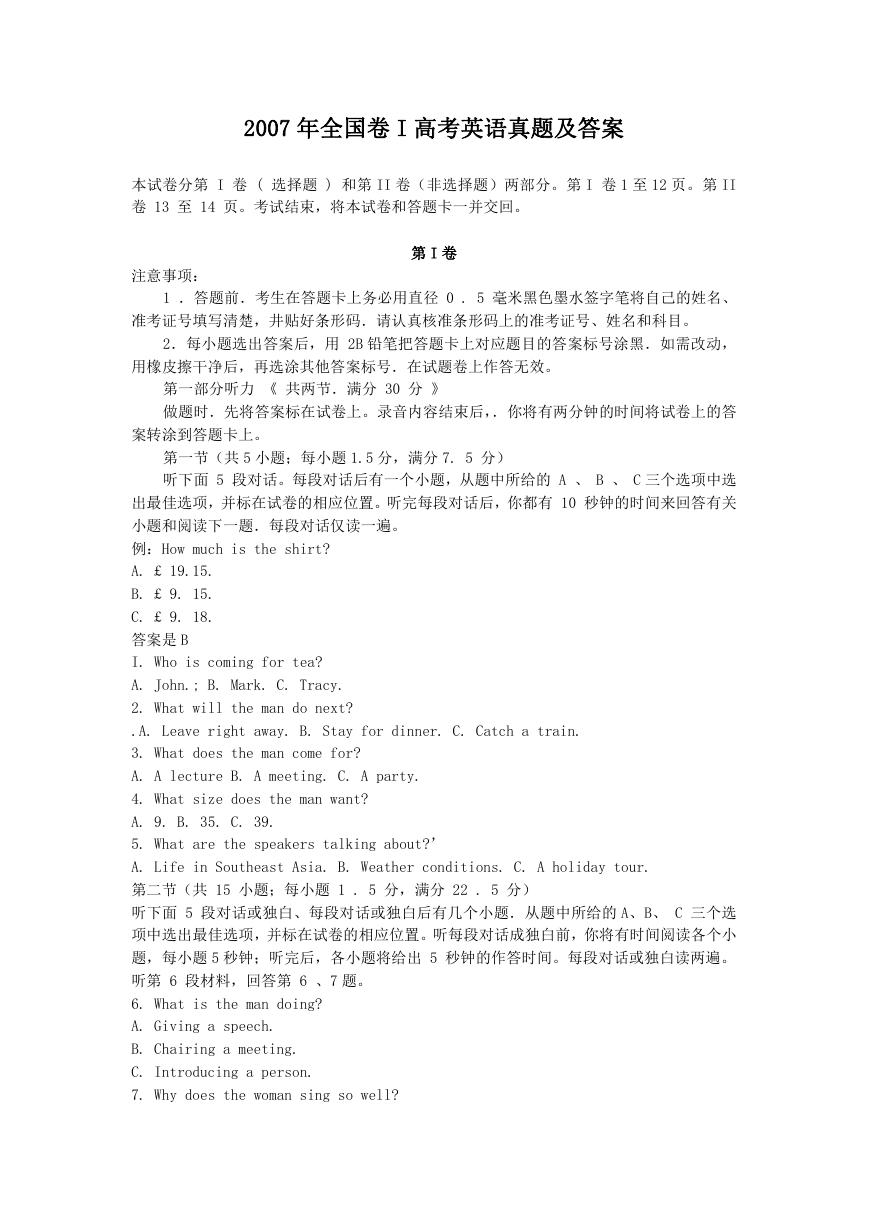

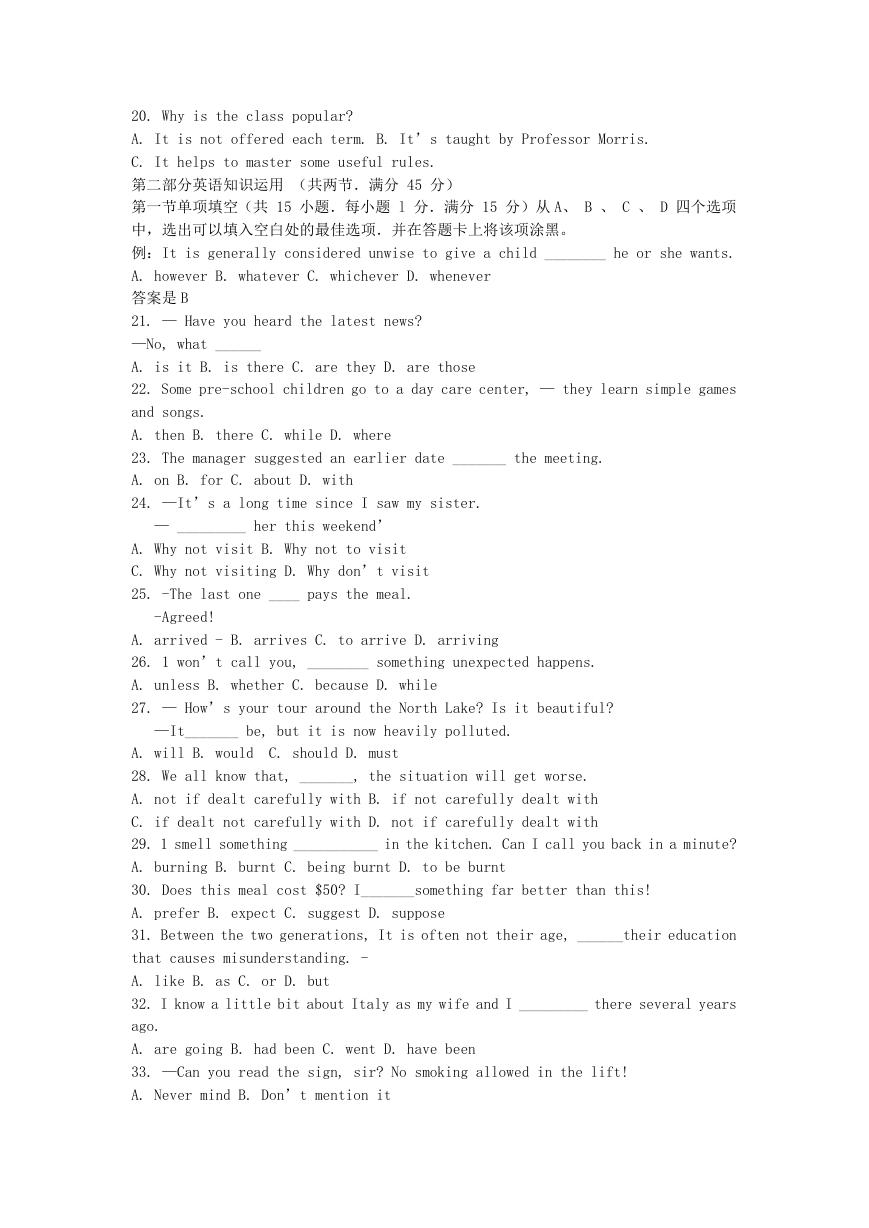
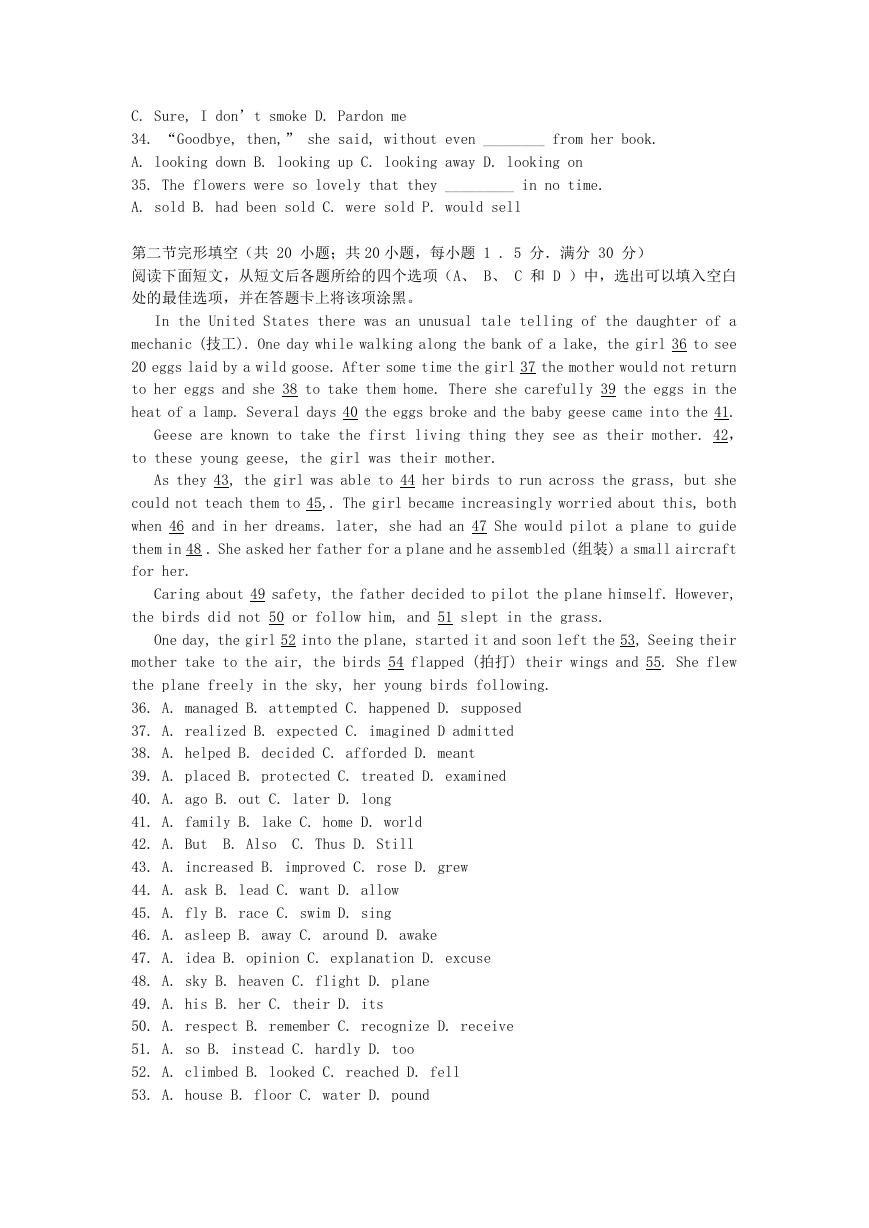
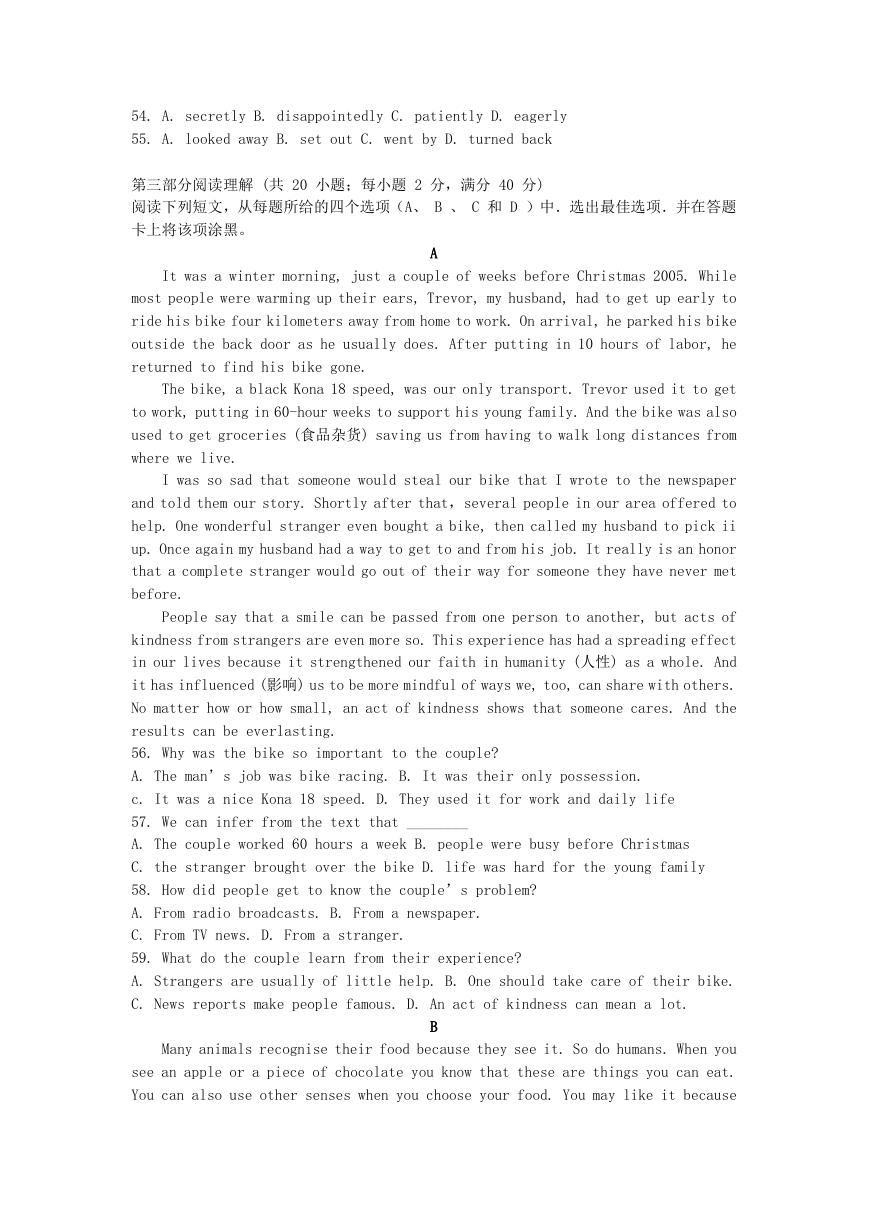


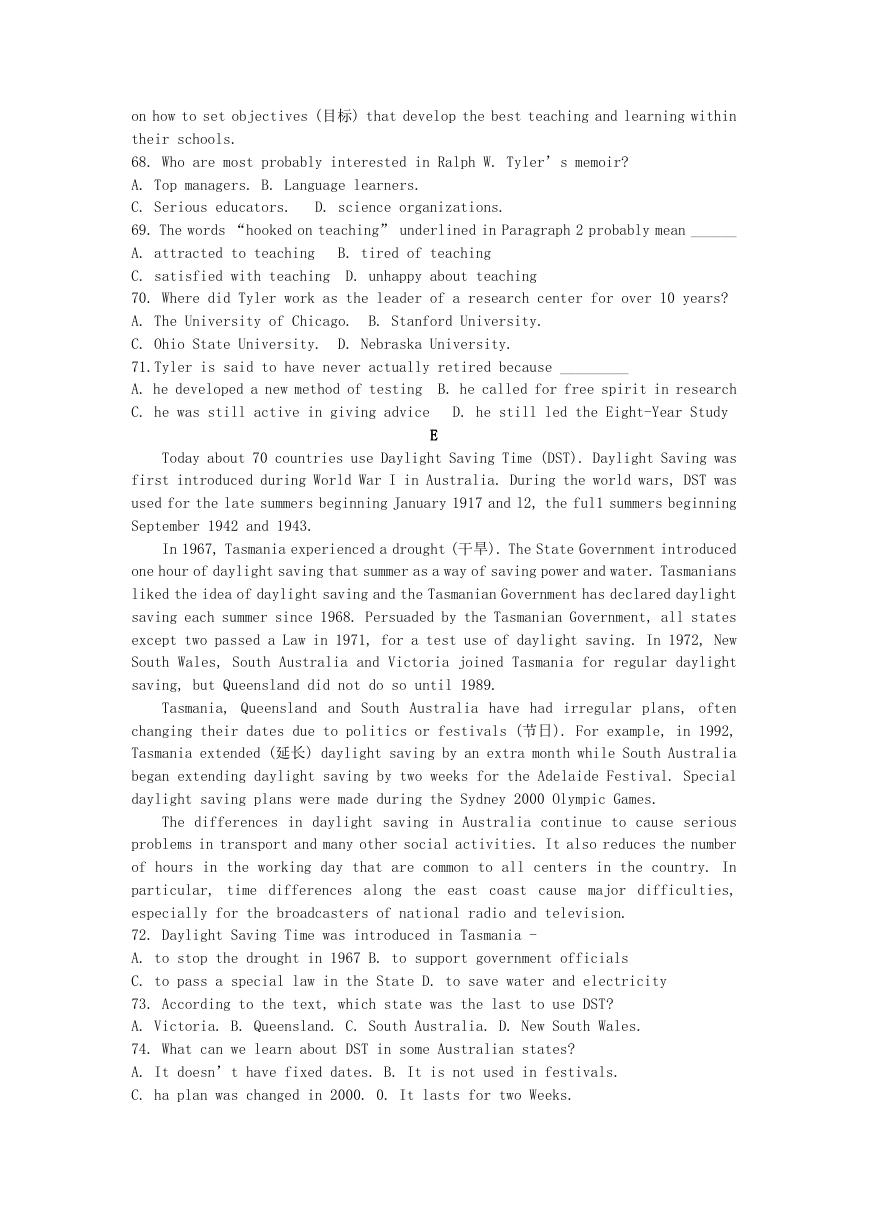








 2023年江西萍乡中考道德与法治真题及答案.doc
2023年江西萍乡中考道德与法治真题及答案.doc 2012年重庆南川中考生物真题及答案.doc
2012年重庆南川中考生物真题及答案.doc 2013年江西师范大学地理学综合及文艺理论基础考研真题.doc
2013年江西师范大学地理学综合及文艺理论基础考研真题.doc 2020年四川甘孜小升初语文真题及答案I卷.doc
2020年四川甘孜小升初语文真题及答案I卷.doc 2020年注册岩土工程师专业基础考试真题及答案.doc
2020年注册岩土工程师专业基础考试真题及答案.doc 2023-2024学年福建省厦门市九年级上学期数学月考试题及答案.doc
2023-2024学年福建省厦门市九年级上学期数学月考试题及答案.doc 2021-2022学年辽宁省沈阳市大东区九年级上学期语文期末试题及答案.doc
2021-2022学年辽宁省沈阳市大东区九年级上学期语文期末试题及答案.doc 2022-2023学年北京东城区初三第一学期物理期末试卷及答案.doc
2022-2023学年北京东城区初三第一学期物理期末试卷及答案.doc 2018上半年江西教师资格初中地理学科知识与教学能力真题及答案.doc
2018上半年江西教师资格初中地理学科知识与教学能力真题及答案.doc 2012年河北国家公务员申论考试真题及答案-省级.doc
2012年河北国家公务员申论考试真题及答案-省级.doc 2020-2021学年江苏省扬州市江都区邵樊片九年级上学期数学第一次质量检测试题及答案.doc
2020-2021学年江苏省扬州市江都区邵樊片九年级上学期数学第一次质量检测试题及答案.doc 2022下半年黑龙江教师资格证中学综合素质真题及答案.doc
2022下半年黑龙江教师资格证中学综合素质真题及答案.doc